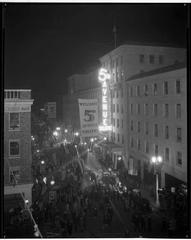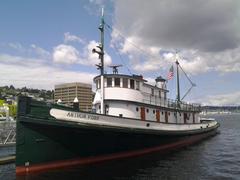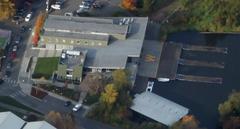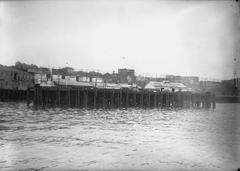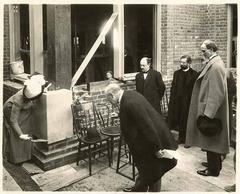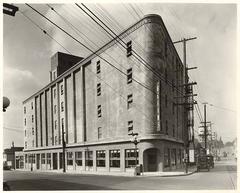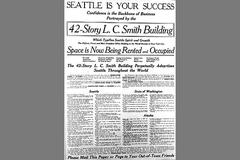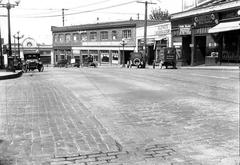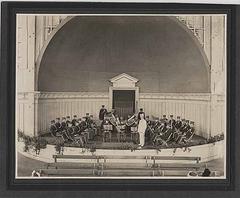
Volunteer Park Conservatory Seattle: Visiting Hours, Tickets, and Complete Guide
Date: 04/07/2025
Introduction
Nestled within Seattle’s vibrant Capitol Hill neighborhood, the Volunteer Park Conservatory stands as both a living botanical museum and a testament to the city’s architectural and cultural legacy. Modeled after London’s Crystal Palace and completed in 1912, this Victorian glasshouse is home to an extraordinary variety of plant collections displayed across five distinct climate-controlled houses. Beyond its horticultural splendor, the conservatory’s preservation is a story of community advocacy, civic stewardship, and the enduring appeal of nature in urban life.
Whether you are a plant enthusiast, a lover of history, or seeking a peaceful retreat, Volunteer Park Conservatory invites you to step inside, explore its lush displays, and discover one of Seattle’s most cherished landmarks. This guide details everything you need to know for your visit, including hours, ticketing, accessibility, historical highlights, and insider tips.
For the most current information on visiting hours, admissions, and events, always consult the official Volunteer Park Conservatory website.
Table of Contents
- Introduction
- History and Cultural Significance
- Architectural Features
- Visiting Information
- Exploring the Conservatory
- Visitor Amenities and Policies
- Nearby Attractions
- Frequently Asked Questions (FAQ)
- Summary and Visitor Tips
- References
History and Cultural Significance
Early Origins and Park Development
Volunteer Park’s roots date to 1876, when the City of Seattle purchased the land for $2,000, transforming it from municipal use and cemetery grounds into a public green space. In 1901, it was renamed Volunteer Park to honor Spanish–American War volunteers (Wikipedia, HistoryLink).
Landscape architect John Charles Olmsted and the Olmsted Brothers firm designed the park’s layout in 1903, accentuating its hilltop vistas and integrating formal lawns, plantings, and recreational amenities. Their vision established Volunteer Park as a central feature of Seattle’s Olmsted park system (HistoryLink).
Conception and Construction of the Conservatory
Inspired by Victorian-era fascination with exotic plants and glasshouse architecture, the city commissioned the conservatory in 1912, assembling a prefabricated kit from Hitchings & Company of New York. The finished conservatory features 3,426 glass panes and ornate ironwork, quickly earning its nickname as the “jewel box” of Seattle’s Olmsted parks (Volunteer Park Conservatory History).
Growth, Preservation, and Community Stewardship
Over the decades, the conservatory’s collections expanded, and it served as a vital botanical repository, even becoming a U.S. Fish and Wildlife Service repository for restricted plants. Facing decline by the late 20th century, community members rallied to save the structure, raising funds and forming the Friends of the Conservatory (FOC) to provide ongoing volunteer and financial support (Volunteer Park Conservatory History, Wikipedia).
Restoration efforts since the 1980s, led by FOC and Seattle Parks & Recreation, have preserved the conservatory’s architectural integrity while upgrading its facilities. Today, it welcomes over 150,000 visitors annually and continues to thrive as a site of education, conservation, and community celebration (Volunteer Park Conservatory).
Architectural Features
Volunteer Park Conservatory exemplifies Victorian glasshouse design with its arched windows, central dome, and intricate ironwork. Spanning over 6,200 square feet, its five display houses each maintain unique microclimates, enabling the cultivation of a diverse array of plant species from tropical, temperate, and arid regions (Conservatory Heritage Society).
A notable highlight is the original “peacock window” above the main entrance, a remnant of the conservatory’s 1912 craftsmanship.
Visiting Information
Hours and Admission
- Open: Tuesday through Sunday, 10:00 AM – 4:00 PM
- Closed: Mondays and major holidays
- Last Admission: 3:45 PM
- Admission Fees:
- Adults (18+): $6
- Youth (6–17), Seniors (65+), College Students, Military, Adaptive: $4
- Children (5 and under): Free
- Annual Passes: $30 (individual), $40 (family/household)
- Free Admission: First Thursday of each month for all; first Saturday youth (12 and under) free with adult ticket
- Tickets: Purchase onsite at entrance kiosks (Volunteer Park Conservatory Admissions)
Donations are always encouraged to support ongoing preservation and programming.
Accessibility
- The conservatory is fully ADA-compliant with level, paved pathways and accessible restrooms nearby.
- Service animals are welcome.
- Staff available for assistance as needed.
Getting There and Parking
- Address: 1400 East Galer Street, Seattle, WA 98112
- Parking: Free street parking around Volunteer Park; disability spots near the entrance
- Public Transit: Served by several Metro bus routes; about a 20-minute walk from downtown (2TravelDads)
Exploring the Conservatory
Display Houses and Plant Collections
The conservatory is divided into five distinct houses, each offering a unique botanical experience:
| House | Main Plant Types | Temperature (°F) | Humidity (%) | Notable Features |
|---|---|---|---|---|
| Palm House | Palms, orchids, cycads | ~72 | >60 | Tallest section, rare orchids, historic jade tree |
| Bromeliad House | Bromeliads, cycads | 72–80 | >60 | Air plants, ant plants, tropical American species |
| Fern House | Ferns, carnivorous | 72–80 | >60 | Venus flytraps, sundews, pitcher plants |
| Cactus House | Cacti, succulents | 72–95 | >50 | Worldwide desert plants, adaptation displays |
| Seasonal House | Rotating displays | ~65 | >50 | Six seasonal changes per year, color and fragrance |
Highlights include the historic jade tree (over 100 years old), rare orchids, carnivorous plants, and vibrant bromeliads. The Seasonal House rotates themed exhibits six times a year, ensuring fresh experiences for repeat visitors (Plant Succulents).
Guided Tours and Educational Programs
- Docent-led tours: Saturdays at 1:00 PM, Sundays at 2:00 PM (reservations recommended during peak seasons)
- Workshops & Programs: Educational events for all ages, covering plant care, conservation, and horticulture
- Special Exhibits: Holiday displays, Spring Bloom Festival, and rare plant events (like the “Corpse Flower” bloom)
Check the events calendar for schedules and updates.
Visitor Amenities and Policies
Gift Shop
Located adjacent to the Palm House, the gift shop offers conservatory-grown plants, gardening books, souvenirs, and botanically inspired gifts. Purchases support the Friends of the Conservatory.
Facilities
- Restrooms are located nearby in Volunteer Park.
- Benches, picnic areas, and water fountains are available in the park.
Policies
- Accessibility: Wide, level pathways; best for wheelchairs and walkers
- Strollers: Discouraged inside due to narrow aisles; stroller parking available at the entrance
- Photography: Casual photos and sketching allowed; formal photo shoots require pre-approval
- Pets: Only service animals permitted
- Children: Supervise closely, especially in the Cactus House
Nearby Attractions
Make the most of your visit by exploring:
- Seattle Asian Art Museum: Renowned Asian art collections within Volunteer Park
- Volunteer Park Water Tower: Historic structure with panoramic city views
- Lily Ponds and Dahlia Gardens: Tranquil spots for relaxation
- Capitol Hill Neighborhood: Cafes, shops, and additional cultural sites
Frequently Asked Questions (FAQ)
Q: What are the Volunteer Park Conservatory visiting hours?
A: Tuesday–Sunday, 10:00 AM–4:00 PM; closed Mondays and major holidays.
Q: How much is admission?
A: $6 for adults; $4 for youth, seniors, students, military, and adaptive; children 5 and under free.
Q: Are there free admission days?
A: Yes, first Thursday of each month (all visitors), first Saturday (youth with adult ticket).
Q: Is the conservatory accessible?
A: Yes, fully ADA-compliant with level pathways.
Q: Can I bring my pet?
A: Only service animals are allowed.
Q: Are guided tours available?
A: Yes, on Saturdays and Sundays; check the website for details.
Q: Where can I park?
A: Street parking surrounds Volunteer Park; disability spots are near the entrance.
Q: Is photography permitted?
A: Yes, but formal shoots require approval.
Summary and Visitor Tips
Volunteer Park Conservatory is a botanical and architectural gem, bridging Seattle’s historical past with its vibrant present. Thanks to ongoing community advocacy and city support, it remains a sanctuary for rare plant life, education, and urban respite. Plan your visit during quieter morning hours for the best experience, explore the rotating seasonal displays, and combine your trip with the many attractions of Volunteer Park.
Stay updated with current hours and events by visiting the official Volunteer Park Conservatory website. Enhance your visit with guided tours via the Audiala app, and support the conservatory through memberships or donations to the Friends of the Conservatory.
References and Further Reading
- Volunteer Park Conservatory Visiting Hours and History - Seattle Historical Site Guide
- Volunteer Park Conservatory Official Website
- Volunteer Park Conservatory Map and Plant Collections
- Volunteer Park Conservatory Admissions, Hours & Directions
- Wikipedia: Volunteer Park Conservatory
- HistoryLink: Volunteer Park History
- Plant Succulents Guide to Volunteer Park Conservatory
- 2TravelDads Seattle Guide
- Volunteer Park Trust Activities
- Conservatory Heritage Society

